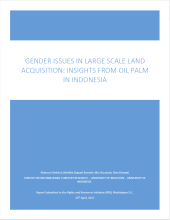Land Library
Bienvenue dans la bibliothèque du Land Portal. Explorez notre vaste collection de ressources en libre accès (plus de 74 000), comprenant des rapports, des articles scientifiques, des articles de recherche, des publications évaluées par des pairs, des documents juridiques, des vidéos et bien plus encore.
/ library resources
Showing items 1 through 9 of 40.To ensure a better and more sustainable future for all, the 2030 Agenda for Sustainable Development (“the 2030 Agenda”) has identified 17 Sustainable Development Goals (SDGs) to be achieved by 2030.
This publication provides practical and evidence-based guidance on how to improve women’s access to land as an essential element to achieve social and economic development and enjoyment of human rights, peace and stability in the specific context of the Muslim world.
This Expert Group Meeting (EGM1 ) was convened with the purpose of examining land indicators in the Sustainable Development Goals (SDGs) and promoting meaningful and harmonised approaches to monitoring women’s land rights (WLR)2 .
The oil palm boom in Indonesia continues to be a major driver of land acquisitions in remaining tropical forest frontiers, drawing on a wide range of actors into its production, and transforming both rural landscapes and livelihoods in the process.
The study tried to assess the state of data in India, particularly to track and report two critical land governance indicators viz. women land rights and forest rights, critical to ensure equity and sustainability in terms of public policy.
This Backgrounder is the first in a multi-authored series on Cultivating Gender Justice.
Poor rural women in developing countries are critical to the survival of their families. Fertile land is their lifeline. But the number of people negatively affected by land degradation is growing rapidly.
To understand more about people’s perceptions of the security of property rights, in India and in the rest of the world, we launched a series of surveys. The first survey was carried out with 14,000 respondents in 14 states across India.
The study examined the status of women’s land rights in India, using Agricultural Census data, with state-wise and district-wise granularity and presents tables and maps depicting women’s land rights against indicators, further segregated across ethnicity and socio-economic categories.



